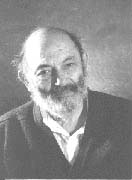
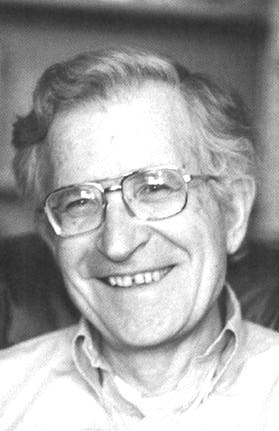
Rich
Phonology:
Some Background Material
Robert F.
Port
Indiana University
1. Formal linguistics assumes a
low-dimensional fixed phonetic segment inventory.
Chomsky,
N., & 

Halle, Morris
(1954) The
strategy of phonemics. Word
10, 197-209.
This
is an early paper by Halle of some historical interest, in which some
strikingly hopeful views about phonetics are
voiced. He points out most people assume ``we speak
in a manner quite similar
to the way in which we write'' -- that ``speech consists of
sequences of discrete sounds which are tokens of a small number of
basic types'' -- direct auditory analogs of graphical letters.
However, acoustic analysis of speech sound has shown, he says, that
speech is
``a
continuous flow of sounds, an unbroken chain of movements.'' He
hypothesizes (as he must) that the ``acoustical wave must contain clues
which enable human
beings to'' segment speech into into discrete events. (I believed
that myself for many years.)
``If we could
state what these clues are, we could presumably build a machine to
perform the same operation.'' Exactly. But
unfortunately no such
machine has been
built in the succeeding half century. In 1954, it may have seemed
a good bet that phoneticians and speech engineers would soon succeed.
But in 2006, it is no longer reasonable to assume that a low-D
description of the physical form of language that is speaker
independent and segmented into Cs and Vs will still be
discovered. We simply must give up the hope for an apriori
phonetic description that is both physical and acoustic, yet also
abstract and linguistic.
Haugeland,
John (1985)
Artificial Intelligence: The Very Idea. (
Haugeland's goal was to clarify the
assumptions of formalist models of cognition. These basic
assumptions are shared across computing, logic, artificial intelligence
and formal models of language and cognition. Major proponents of this
view include Chomsky,
Newell and Simon,
Fodor, Pylyshyn, Pinker, etc. Computers are
carefully engineered so that they can be interpreted in terms of
discrete
states only. Programmers (unlike computer engineers) do not need
to concern themselves with continuous time or continuous values of
voltage. Formal
linguistics always assumes an apriori set of
letter-like phonetic tokens. Thus it must presume the
physical existence of a fixed alphabet of phonetic symbols for spelling
linguistic items, as well as a discrete computational apparatus for
token manipulation. All
formal
linguistic theories build upon this assumption even though it is surely
very implausible
and the empirical claim of a universal phonetic alphabet has scarcely
even been defended by phonologists. (I am sure there must have
been
attempts, but I'm not familiar with them.) Chomsky and Halle
(1968) took
it to be intuitively obvious that such a fixed and small
inventory (under
a few hundred) of universal phonetic tokens exist. So the
problem, I claim, is that no such low-dimensional description of
phonetics is possible (See Port and Leary, 2005). Therefore
formal linguistics is impossible.
2. Segments are not compatible with spectrographic
representations.
IPA,
1999. Handbook of the
International Phonetic Association. Introduction.
(pp 3-13, 27-30, 32-38).
This
thoughtful and wide-ranging chapter of the recent edition of the IPA Handbook (by Prof. John
Wells of
Klatt, Dennis (1979) Speech
perception: A model of acoustic phonetic analysis and lexical access.
Journal of Phonetics 7,
279-342.
Klatt presents two generic models for
recognizing speech in this important paper: LAFS
and Scriber.
LAFS (``lexical access from spectra'') recognizes words specified in
raw acoustic form. No segment level at all! Given all the
variations due to
context, speaker, etc, this implies there will be many alternative
acoustic
representations
for each speech chunk (whether word, phrase or what). Today, all
effective speech recognition systems work basically this way, usually
implemented as hidden Markov models on sequences of spectral
shapes (specified in a rather large `alphabet' of spectral
shapes).
But Scriber works
the
``right''
way (according to the insights of linguistics) since it converts
spectra into abstract
segmental, letter-like units, and then recognizes words and other
speech chunks using the resulting transcriptions. Back in the
1980s, my Indiana
colleague
David Pisoni always liked this paper and thought that LAFS was a model
that deserved serious consideration. But I, as a linguist-phonetician,
thought that LAFS could not
possibly be correct. I remember being almost
annoyed
that Dennis Klatt even suggested such a thing. ``Oh well,'' I thought,
``he
is just an engineer. Psychological plausibility is not so important for
engineers.'' This paper
appeared in
1979, only 3 years after I got my PhD, and now, 30 years later, I
realize that the general approach of
LAFS was the right choice all
along! And is, in fact, the only psychologically
plausible approach. The
Scriber approach, despite its
great intuitive appeal to any alphabet-literate person, is not
guaranteed to work.
Huckvale, Mark (1997) 10 things engineers
have discovered about speech recognition. NATO ASI Workshop
on Speech Pattern Processing. pp. 1-5.
This paper has many surprises for
linguists. ``This paper is about what happens when you put
Performance first'' -- relative to Competence. Huckvale has many
humbling things to say to linguists.
Ladefoged, Peter (2004) Phonetics and phonology in
the last 50 years. Paper presented at `From Sound to Sense',
a conference at MIT.
This interesting paper on the history of
phonetics presents his concerns about the
gross mismatch between segmental
linguistic descriptions of
speech and the acoustic signal. He concludes rather disturbingly:
``phonologists have the problem of deciding whether they are describing
something that actually exists, or whether they are dealing with
epiphenomena, constructs that are just the result of making a
description.'' My conclusion, of course, is the latter, and I
think Ladefoged's was as well.
Ladefoged, Peter
(2005) Features
and parameters for different purposes. Paper presented to
the Linguistic Society of America, 2005.
This paper presents Ladefoged's final views on phonetics and phonology before his passing in January, 2006. Using generally different arguments than mine, he concludes that a full description of speech requires far more degrees of freedom than Chomsky and Halle propose and that a grammar could not possibly be ``just something in some speaker's mind.'' Instead he proposes that the phonology of a language is ``a social institution,'' while ``the acts of speaking and listening all involve adjusting articulatory parameters not phonological features.'' On the other hand, he says, ``phonological features are best regarded as artifacts that linguists have devised in order to describe linguistic systems.'' Although he does not develop these ideas much beyond these statements, this appears to be essentially identical to my position: phonology is a social institution existing on a slow time scale and real-time language processing makes no use of abstract phonological descriptions at all.
3. Variation is endless when you look close.
Labov, William. (1964) Phonological
correlates of social stratification. American Anthropologist 66, 164-176.
The
first paper is Labov's fascinating MA thesis and the second reviews the
results of his dissertation on language variation on the Lower
East Side of NYC.
Labov revealed vividly the subtlety in dialect variation. Of
course, each
individual speaks a different dialect, but in fact, we each speak in
many different
styles of pronunciation detail. Our theories of language presume
there
is a linguistic state, something we could call `The English Language'
or maybe
`Lower East Side English' -- in any case, some invariant Grammar.
But Labov's data show
us (in my view, not necessarily his) that no such
entities are definable in fact. Everything is always subject to
subtle phonetic variation. All we can know about a language
is distributional patterns in a high-D auditory/phonetic space.
Traditional theories of language presume that speaker and hearer share
some common Grammar. But the fact is they never ever
share the same grammar! And every word has an unlimited
number
of
variants! So why do linguists imagine they could describe
some dialect
or other in discrete low-D terms?
Bybee, Joan (2002) Word frequency and context of use in the lexical diffusion of phonetically conditioned sound change. Language Variation and Change 14, 261-290.
Bybee and other variationists have explored the ways that the
distribution of
variants for any word is influenced by such properties as the frequency
of occurrence of each
individual word -- as well as many other factors.
If every word has a bazillion variants, what can it mean to say ``I
know Word X''? Apparently it must mean either (A) ``I know the
list of (essentially) all variants'' or, perhaps, (B) ``I am able to
evaluate utterances for their similarity to the
whole distribution of variants of Word X.'' This does not
resemble what generative phonologists are doing -- but they too think
they are
explicating what it means to know Word X.
4.
Long-term
memory, including memory for words, is far richer
than we thought.
Palmeri,
T. J., Goldinger, S. D., & Pisoni, D. B. (1993). Episodic
encoding of voice attributes
and recognition memory for spoken words. Journal of
Experimental
Psychology, Learning, Memory and Cognition, 19,
309-328.
This paper presents powerful evidence
from a `recognition memory' task
that our memory for speech is not abstracted away from speakers'
voices, as linguists and phoneticians tend to think (as claimed
explicitly by Morris Halle, 1954 and 1985). We actually store
lots of
phonetic
detail including speaker idiosyncrasies. This set of results
troubled
me for over a decade until I finally decided that I should try
to consider that the data might actually mean what they seem to mean --
that an
abstract phonological transcription of speech does not
do the primary job of linguistic memory and does not limit what is
stored in memory.
This mental exercise is what led to the revolutionary
theory being presented here. One implication of these
results is
that we store far more detailed information about speech than we
linguists
ever imagined. It also implies we store speech in a very
concrete,
auditory fashion -- not using abstract speaker-independent and
context-free descriptors. Thus, a memory including specific
examples (as well as prototypes and abstract
specifications) is implicated. It turns out that lots of data
from
many areas of psychology have been implicating such representations for
a long time.
Hintzman,
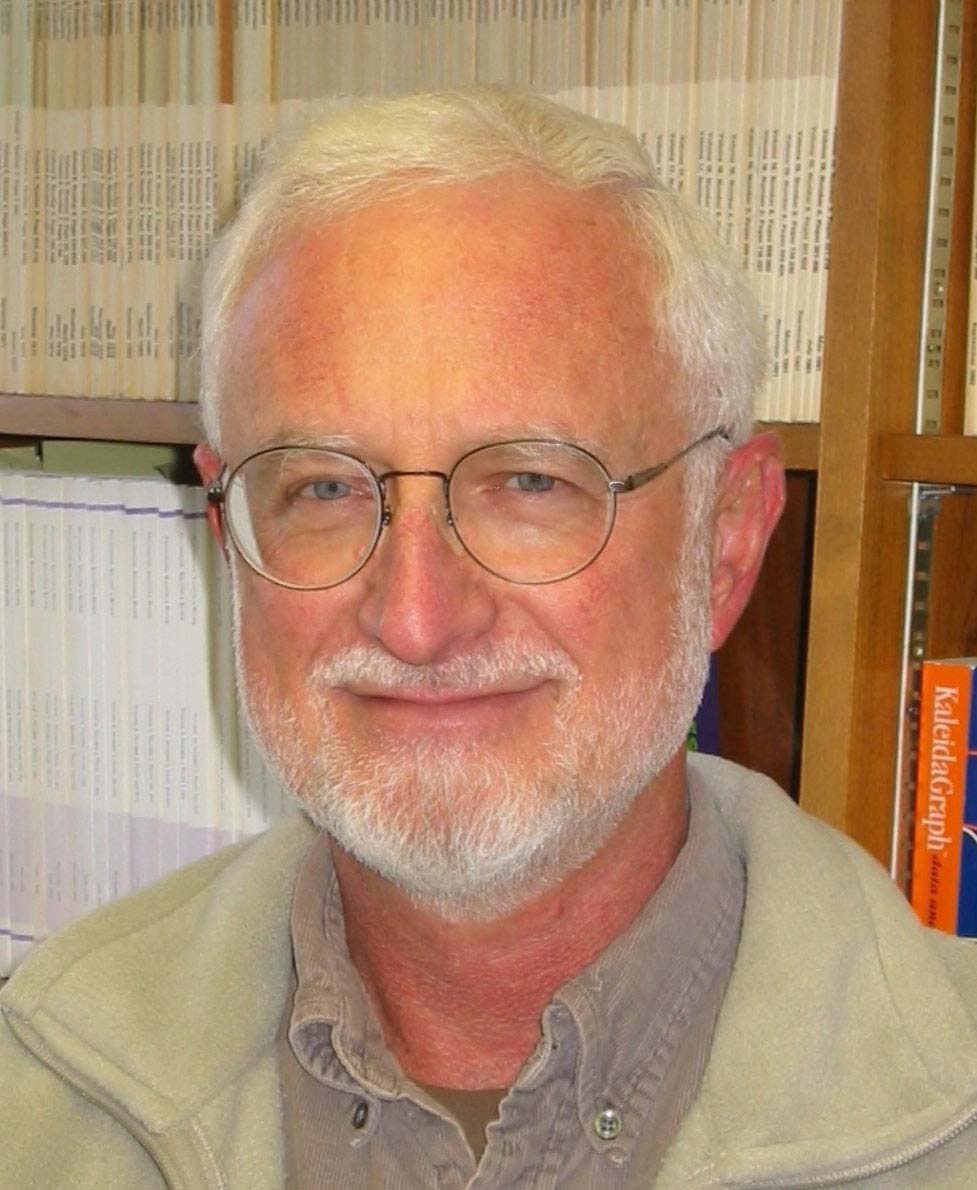
This, the granddaddy of mathematical memory models, is called
Minerva2,
and is easier to
understand than most since the math is simple linear
algebra. You
will see how a rich and detailed memory of concrete exemplars with no
abstractions can perform better on training tokens yet still allow
abstractions (and prototypes) to be computed on the fly whenever
needed. Many more recent models (e.g., by Nosofsky and Shiffrin)
use
different mathematics but retain a key role for the training exemplars
to predict results. (The pic: Doug
Hintzman.)
O'Reilly, Randall and Kenneth Norman (2005) Hippocampal
and
neocortical contributions to memory: Advances in the complementary
learning systems
framework. Trends in Cognitive Sciences 6,
505-510.
This proposes
a neural model for `episodic memory,' that
is,
memory of randomly coocurring events (eg, the words you hear
someone
say to you, or the specific events that happened on the way to work
this morning) that represents stored information on a single trial.
Gluck, M., M.
Meeter and C.E. Meyers (2003) Computational
models of the
hippocampal region: linking incremental learning and episodic
memory.
Trends in Cognitive Science 7, 269-276.
The point of these papers is that there are neurologically plausible
mechanisms that can learn details of specific examples of complex,
multimodal
episodes on a single trial without repetitive
training. These papers suggest that a surprising amount of rote
material
could be available in the memory of speaker-hearers. Remembering
all examples forever is not plausible, but we apparently remember much
richer detail -- including language detail -- than most of us imagined.
Any implications for the study of language? Of course.
Pisoni,
D. B. (1997). Some
thoughts on `normalization' in speech perception. In K. Johnson
& J.
Mullennix (Eds.), Talker variability in speech processing (pp.
9-32).
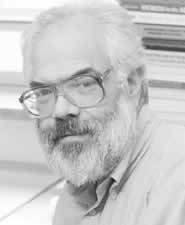 Lachs,
Lorin,
Kipp McMichael and D. B. Pisoni (2000) Speech perception and
implicit
memory: Evidence for detailed episodic encoding of phonetic
events. In J. Bowers and C. Marsolek (eds.)
Rethinking Implicit Memory
(Oxford:
Oxford Univ Press).
Lachs,
Lorin,
Kipp McMichael and D. B. Pisoni (2000) Speech perception and
implicit
memory: Evidence for detailed episodic encoding of phonetic
events. In J. Bowers and C. Marsolek (eds.)
Rethinking Implicit Memory
(Oxford:
Oxford Univ Press).
Also in Research on Spoken Language
Processing, 24, 149-167 (Psychology Dept, Indiana University).
Pisoni
and colleagues draw the implications
for a theory of language of the fact that people use an
episode-like memory rather than an `abstractionist' model of speech
(like phones or
phonemes). Lachs et al. point out that the traditional
perspective on speech perception assumes that linguistic information
and contextual information are stored independently. Instead they
argue their data support a ``single complex memory system that retains
highly detailed, instance-specific information in a perceptual record
containing all of our experiences -- speech and
otherwise.''
They are calling for a new kind of linguistics that lets go of the
assumption of discrete abstract units. Such a theory of language
is what I am now trying to initiate with this website.
Pierrehumbert,
Janet (2001) Exemplar
dynamics: Word frequency, lenition and contrast. In J. Bybee
and P.
Hopper (eds) Frequency Effects and the Emergence of Linguistic
Structure. (Benjamins,
She explains exemplar models (based on Hintzman) in her own
way and
addresses the question of how an exemplar model of memory might make
predictions about speech production. She proposes that the
perceived
(and stored) distribution can be a direct model of production
probabilities. So her algorithm for choice in speech production
is
simply the distribution of perceived tokens treated as a probability
distribution
of production targets selected from randomly. This is one
of the first attempts
by a
linguist to consider the implications of detailed exemplar memory
representations of speech.
Johnson,
Keith (2005, mspt) Decisions
and mechanisms in
exemplar-based phonology. UC Berkeley Phonology
Lab Annual Report 2005. Johnson considers some
issues that will trouble linguists about exemplar models of memory for
language.
5. What modality are phonetic
targets?: articulatory, auditory, somatosensory?
Liberman,
Alvin M., Franklin S. Cooper, Donald P. Shankweiler and Michael
Studdert-Kennedy
(1968) Perception
of 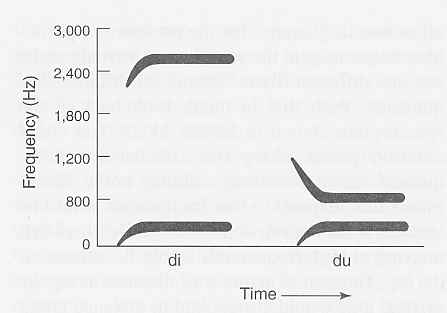 speech
code. Psychological
Review 74,
431-461. Reproduced in J. Miller, R. Kent and B. Atal
(eds.) (1991) Papers in Speech
Communication: Speech Perception. (Acoustical Society of
America, Woodbury, New York).
speech
code. Psychological
Review 74,
431-461. Reproduced in J. Miller, R. Kent and B. Atal
(eds.) (1991) Papers in Speech
Communication: Speech Perception. (Acoustical Society of
America, Woodbury, New York).
A monumental review paper summarizing the
Haskins Labs
view of speech perception arguing for the `motor theory of speech
perception'. This group thought that words must be
specified in
memory in low-dimensional, segmental and articulatory terms, so
the di/du
problem (illustrated at right) was major. But if auditory
memory is
very large, then speakers can just store context-sensitive formant
trajectories and burst spectrum shapes. The fact that di and du
begin with what we call ``the same sound'' may be something that is
noticed by most speakers
only after learning to write
with an alphabet. At least
this issue about what speech sounds ``sound the same'' needs more
research.
Lindblom, Björn (2004)
The organization of speech movements: Specification of units and modes
of
control. Paper presented at conference `From Sound to Sense'
at
MIT. A survey of speech production theories.
Diehl,
Randy, Andrew Lotto and Lori Holt (2004) Speech
perception. Annual Review of Psychology 55,
149-179. Presents that case that, no
matter what, the
basic representations of word targets must be auditory.
Gallantucci,
Fowler and Turvey (2006) The
motor theory
of speech perception reviewed. Psychonomic
Bulletin and Review 13,
361-377.
Guenther, Frank (1995)
Speech sound acquisition,
coarticulation and rate effects in a neural network model of speech
perception. Psych Review 102, 594-621.
Guenther,
Frank and Joseph Perkell (2004) A
neural model of speech
production and supporting experiments. Paper presented at `From
Sound to
Sense', conference at MIT, June 2004. Available at
http://www.rle.mit.edu/soundtosense/.
Speech sounds must have both convenient articulatory properties and practical auditory properties. Diehl, Lotto and Holt argue for a speech perception process using only general auditory capabilities (rather than unique specialized perceptual skills that are used for speech and nothing else). Clearly, my position is closer to theirs than to the traditional Haskins Labs view. Guenther's feedforward production system just produces gestures -- normally with no feedback. But the primary realtime guidance for them is based on somatosensory (ie, orosensory) feedback (from muscles, joints and skin surfaces). So the best answer to a question about realtime targets is: the targets are somatosensory, and neither gestural nor auditory. So I don't agree (with Galantucci-Fowler-Turvey) that ``perceiving speech is perceiving gestures'' (their claim number 2), it is just perceiving speech. But their claim 3 that ``the motor system is recruited for perceiving speech'' seems to be true and provides a coherent, reliable coding method for storing speech patterns. (See Stephen M. Wilson, 2004, Listening to speech activates motor areas involved in speech production. Nature Neurosci.)
The issue regarding short-term memory (STM) is how words
are stored for
short periods of
time -- under 20 sec or so. Baddeley uses the term `phonological
loop'
for the system that
stores a small number of words for a few seconds. Linguists might
assume that he means the same thing they mean when using the term
``phonological''. But his data show that this
code is either an auditory code or an articulatory one -- but it is
definitely not the kind of
abstract, segmented, speaker-invariant code that linguists think of
when they
use this term. So the code is either motor or auditory (or
both). Note that Baddeley claims the phonological loop has two
parts
-- a
store or buffer (which exhibits confusion between words that sound
similar even
if articulated quite differently) and a (subvocal) motor representation
used
for rehearsal (which accounts for why Ss can remember fewer longer
words than
shorter ones, ie, the `word-length effect.'
Baddeley, Alan, D. (2002) Is
working memory still working? European
Psychologists 7, 85-97
In
this paper Baddeley extends his earlier model in a useful way by added
an `episodic
buffer'
-- a store for information from many modalities that is retained
for
awhile.
7. Why
are letters so convincing despite all the evidence? Because of
our education.
Olson, David R.
(1993) How
writing represents
speech. Language and Communication
13. 1-17. This article is a revised
version of Chapter 4 in his outstanding and highly recommended book: The World on Paper: The Conceptual and
Cognitive Implications of Writing and Reading. (Cambridge:
1994). He points out that various human notions of what
language is are invariably based on whatever we represent with our
writing system. So the idea that our alphabetical writing is a
`cipher' (one-to-one replacement) from phonemes into graphemes has
reversed the true order! We linguists tend to believe our
language is
made from phonemes
primarily because we use
letters to represent speech.
 Faber,
Faber,
Faber
anticipated the argument I am making here over a decade
ago. Her
paper has been largely ignored, as far as I can tell. She
argued that
languages seem to be composed from letter-like segments primarily
because we have all been trained in alphabetic literacy.
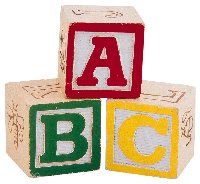 Linguistics.
(Oxford Univ Press,
Linguistics.
(Oxford Univ Press,
These papers show quite clearly that
a segmental description of speech (in terms, that is, of consonants and
vowels)
may be intuitively persuasive for us. But it is
not
universal -- indeed most humans, through our history, have not had such
intuitions.
It appears that some amount of alphabet training is necessary for
people to hear speech in terms of Cs and Vs.
Ziegler,
Johannes and Usha Goswami (2005)
Reading
acquisition, developmental dyslexia and skilled reading across
languages: A
psycholinguistic grain size theory. Psych Bulletin 131, 3-39. 
This
review paper strongly endorses the view that the alphabetical
description of
language
(using phonemes or letters) is a result of learning how to do
alphabetical
reading and writing. It also demonstrates that the inconsistencies in
the
spelling of English greatly complicate the problem of learning to read.
Children taught to read Finnish or Italian can read new words as well
after one
year of school as English-speaking children can do after 3 years of
school. Of course, the latter's practical reading skill may still
be better than a
child
learning to read Chinese after the same amount of
training.
Studies of reading reveal clearly how an understanding
of language in terms of phonemes is almost entirely
a consequence of learning how to read with an alphabet. This
direction of causality agrees
with my general story that segmental descriptions of speech are shaped
and reinforced by extensive practice at reading and writing. But
this
result is in serious
conflict with the conventional views of linguists and psychologists
about
language. The traditional view insists that learning a language
and
remembering vocabulary are skills that depend upon letter-like
phonemes. Some set of letter-like units are said to be available in
advance to all members of the
species. On this view, all
speakers, whether literate or not, should store language using a
cognitive
alphabet. But the data do not support any such predictions.
Of
course, there is the question
of how the alphabet could have been
invented if phonemes lack this intuitive basis. But it should be
kept in mind that
the
early Greek alphabet was the result of roughly 3000 years of efforts in
the middle east to engineer
a culturally transmittable writing system that was easy to
teach and use. And the alphabet
was only
invented once -- as has been pointed out many times. I would
claim
that those Greek `writing engineers' (standing on the shoulders of
earlier middle-eastern writing engineers) actually invented the phoneme
concept itself. The phoneme is the ideal, the conceptual
archetype, for which all alphabetical orthographies are just imperfect
implementations.

Robert F. Port, April 9,
2008